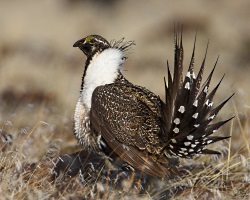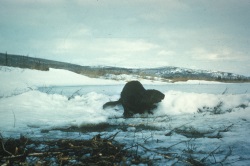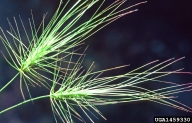USA National Phenology Network

The study of recurring plant and animal life cycle events is phenology. It is the calendar of nature. This includes when plants flower, when birds migrate and when crops mature. Phenology is relevant to interactions between organisms, seasonal timing and large-scale cycles of water and carbon. Phenology is important to us for many reasons. Farmers need to know when to plant and harvest crops and when to expect pests to emerge. Resource managers use it to monitor and predict drought and assess fire risk. Vacationers want to know when the best fall colors will be or when the wildflower blooms will peak. Timing varies but we can discern patterns.
The USA National Phenology Network monitors the influence of climate on the phenology of plants, animals and landscapes. They encourage people to observe phenological events such as flowering, migrations and egg laying. The Phenology Network provides a place to enter, store and share these observations, which are then compiled and analyzed nationwide. Participants range from individual observers in their own backyards to professional scientists monitoring long-term plots. My husband and I monitor leafing and flowering of lilacs, a key species in the program.
These observations support a wide range of decisions made routinely by citizens, managers, scientists and others. This includes decisions related to allergies, wildfires, pest control, and water management.
I urge you to participate. The National Phenology Network has many public, private and citizen partners. It is a great way to become involved in a nation-wide effort to better understand our environment. All this information and much more is available at the National Phenology website, to which there is a link from our Wild About Utah website.
This is Linda Kervin for Bridgerland Audubon Society.
Credits:
Text: Linda Kervin, Bridgerland Audubon Society
Additional Reading:
Linda Kervin’s pieces on Wild About Utah
Phenology Tools for Community Science
USA National Phenology Network, https://www.usanpn.org/
Nature’s Notebook Education Program, US National Phenology Network, https://www.usanpn.org/nn/education
North American Bird Phenology Program, USGS Patuxent Wildlife Research Center, https://www.pwrc.usgs.gov/bpp/BecomeAParticipant.cfm
eBird, https://www.ebird.org/
iNaturalist, https://www.inaturalist.org/
Sage Grouse, Pronghorn Antelope and Fences

Courtesy US FWS
Stephen Ting, Photographer
As Robert Frost famously wrote in his poem, Mending Wall, “Good fences make good neighbors”.
Fences keep livestock from crops, children from traffic and delineate boundaries. In the intermountain West, fences are important to keep livestock where we want them and away from where we don’t. But wildlife of open sagebrush habitat did not evolve with fences. Sage Grouse and Pronghorn Antelope have had a particularly difficult time adapting.
Sage Grouse are stout, chicken-like birds found only in sagebrush, whose foliage features prominently in their diet. Sage Grouse were once abundant, but their numbers have plummeted due to habitat loss. Today they are candidates for listing as an endangered species. In flight, these large bodied birds like to skim over the sagebrush canopy and so doing, careen right into fences. One Utah study attributed 1/5 of Sage Grouse deaths to fence collisions.
[Kevin Colver recording: https://wildstore.wildsanctuary.com/collections/special-collections]

Courtesy US FWS
James C. Leupold, Photographer
At dawn during the spring, male Sage Grouse congregate on ancestral dancing grounds to attract mates. The birds fly to these lek areas before sunrise so may not be able to see a fence before they collide. Other areas of special concern include the crest of low hills and the midst of wide open flats. Where grouse are common, flagging a fence or otherwise making it more visible can help considerably to reduce airborne fence collisions.
For Pronghorn Antelope, however, the top of the fence is not the issue. They are the swiftest game animal in North America. As with bison, market hunting in the 19th century decimated their populations. This trend has reversed, but here also, fences are a problem. Pronghorn are sprinters, not hurdlers and rarely jump a barrier over 3 feet tall. They choose to go under or through fencelines. A simple solution for barbed wire fences is to string smooth wire for the bottom strand at least 18 inches above the ground. This simple fence fix enables pronghorns to scoot below the fence unscathed as they migrate between winter and summer grounds
The perspective of Pronghorn Antelope and Sage Grouse could be summed up in the lyrics from a Cole Porter song: Don’t fence me in.
This is Linda Kervin for Bridgerland Audubon Society.
Credits:
Photos: Courtesy US FWS: Images.fws.gov
Audio: Kevin Colver, https://wildstore.wildsanctuary.com/collections/special-collections
Text: Linda Kervin, Bridgerland Audubon Society
Additional Reading:
Resources:
Lives of North American Birds. Kenn Kaufman. 1996, Houghton Mifflin Company., https://www.amazon.com/American-Peterson-Natural-History-Companions/dp/0395770173
Don’t Fence Me In: If sage-grouse had a song it would be “Don’t Fence Me In”, USDA Natural Resource Conservation Service, https://www.mt.nrcs.usda.gov/technical/ecs/biology/sagegrouse/dontfence.html
Safer Fencing Can Help Save Western Birds, Environmental Defense Fund, https://www.edf.org/article.cfm?contentID=9126
Huddling for Warmth

Image Courtesy US FWS
When temperatures dip below freezing and wind hurries on its way, we often find ourselves looking for another warm body to huddle near and share heat. Children snuggle into laps and dogs lean close.
Many animals huddle to stave off the cold. Species that are strong individualists in balmy seasons seek warmth from a group when temperatures drop. Many non-colonial rodents will share a den come winter.
[Kevin Colver recording: Songbirds of the Southwest Canyon Country]
Pygmy nuthatches jam themselves tightly together into tree cavities as do flying squirrels. Through the winter, worker honeybees huddle tightly around a central patch of wax comb where developing larvae are growing. The larvae die if temperatures drop below 83 degrees, so a living blanket of worker bees shivers to generate the heat equivalent to a 40 watt incandescent bulb.
An animal loses heat in direct proportion to its surface area. By huddling together, each animal reduces its exposed surface area. This in turn allows them to reduce their metabolic rate and so conserve energy at a time when food can be scarce or inaccessible.
Nests or dens occupied by numerous individuals can be much warmer than ambient. A snow covered lodge with at least 2 beaver occupants can be as much as 35 degrees warmer than the outside air temperature. A study of taiga voles showed that underground nests containing 5 to 10 residents remained 7 to 12 degrees warmer than the surrounding soil and up to 25 degrees warmer than the air above. Individuals take turns going out to forage so their nest remains toasty.
Living in close proximity does have its problems. Disease and parasites are readily transmitted in tight quarters. Local food competition could potentially lead to hunger or starvation. Predators may more easily discover prey in groups. But for many animals, the advantages of huddling for warmth far outweigh the risks during our chilly winter months.
This is Linda Kervin for Bridgerland Audubon Society.
Credits:
Photos: Courtesy US FWS
Audio: Courtesy Kevin Colver, https://wildstore.wildsanctuary.com/collections/special-collections, https://wildstore.wildsanctuary.com/collections/special-collections
Text: Linda Kervin, Bridgerland Audubon Society
Additional Reading:
Life in the Cold: An Introduction to Winter Ecology. Peter Marchand. 1991, University Press of New England. https://www.amazon.com/Life-Cold-Introduction-Winter-Ecology/dp/0874517850
Lives of North American Birds. Kenn Kaufman. 1996, Houghton Mifflin Company. https://www.amazon.com/American-Peterson-Natural-History-Companions/dp/0395770173
The Birder’s Handbook. Paul R. Ehrlich, David S. Dobkin and Darryl Wheye. 1988, Simon & Schuster, Inc. https://www.amazon.com/Birders-Handbook-American-including-Regularly/dp/1435277589



